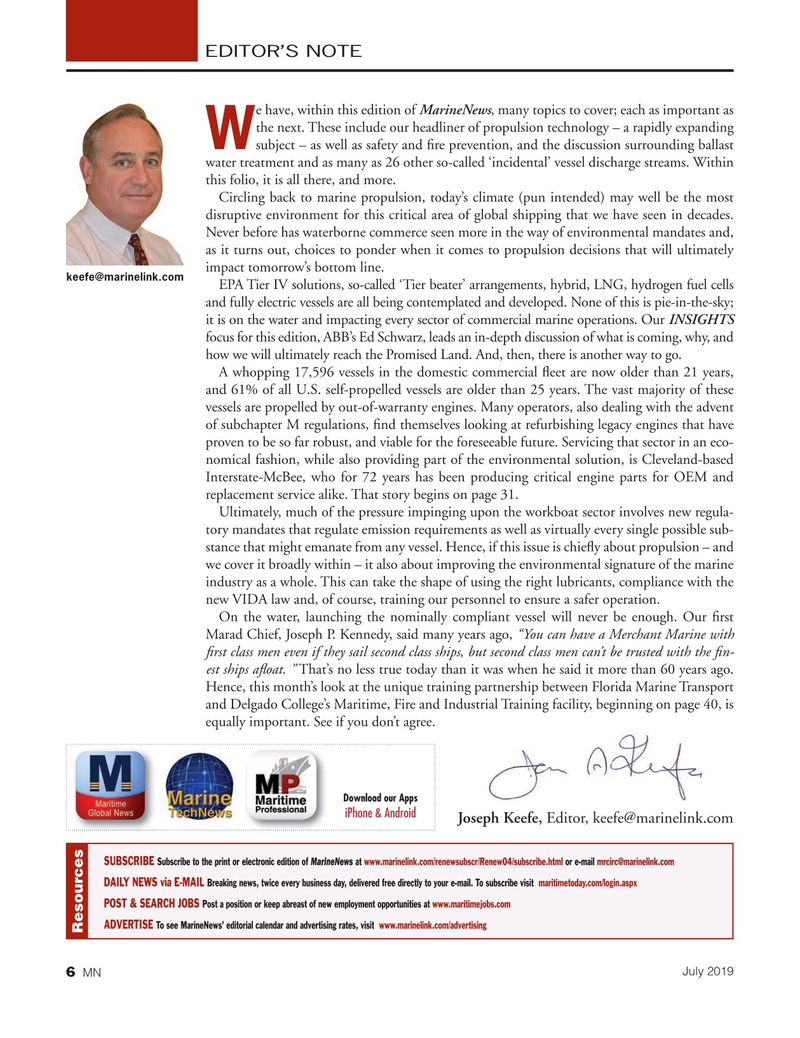
Page 6: of Marine News Magazine (July 2019)
Propulsion Technology
Read this page in Pdf, Flash or Html5 edition of July 2019 Marine News Magazine
EDITOR’S NOTE e have, within this edition of MarineNews, many topics to cover; each as important as the next. These include our headliner of propulsion technology – a rapidly expanding
W subject – as well as safety and ? re prevention, and the discussion surrounding ballast water treatment and as many as 26 other so-called ‘incidental’ vessel discharge streams. Within this folio, it is all there, and more.
Circling back to marine propulsion, today’s climate (pun intended) may well be the most disruptive environment for this critical area of global shipping that we have seen in decades.
Never before has waterborne commerce seen more in the way of environmental mandates and, as it turns out, choices to ponder when it comes to propulsion decisions that will ultimately impact tomorrow’s bottom line.
EPA Tier IV solutions, so-called ‘Tier beater’ arrangements, hybrid, LNG, hydrogen fuel cells and fully electric vessels are all being contemplated and developed. None of this is pie-in-the-sky; it is on the water and impacting every sector of commercial marine operations. Our INSIGHTS focus for this edition, ABB’s Ed Schwarz, leads an in-depth discussion of what is coming, why, and how we will ultimately reach the Promised Land. And, then, there is another way to go.
A whopping 17,596 vessels in the domestic commercial ? eet are now older than 21 years, and 61% of all U.S. self-propelled vessels are older than 25 years. The vast majority of these vessels are propelled by out-of-warranty engines. Many operators, also dealing with the advent of subchapter M regulations, ? nd themselves looking at refurbishing legacy engines that have proven to be so far robust, and viable for the foreseeable future. Servicing that sector in an eco- nomical fashion, while also providing part of the environmental solution, is Cleveland-based
Interstate-McBee, who for 72 years has been producing critical engine parts for OEM and replacement service alike. That story begins on page 31.
Ultimately, much of the pressure impinging upon the workboat sector involves new regula- tory mandates that regulate emission requirements as well as virtually every single possible sub- stance that might emanate from any vessel. Hence, if this issue is chie? y about propulsion – and we cover it broadly within – it also about improving the environmental signature of the marine industry as a whole. This can take the shape of using the right lubricants, compliance with the new VIDA law and, of course, training our personnel to ensure a safer operation.
On the water, launching the nominally compliant vessel will never be enough. Our ? rst
Marad Chief, Joseph P. Kennedy, said many years ago, “You can have a Merchant Marine with ? rst class men even if they sail second class ships, but second class men can’t be trusted with the ? n- est ships a? oat. ” That’s no less true today than it was when he said it more than 60 years ago.
Hence, this month’s look at the unique training partnership between Florida Marine Transport and Delgado College’s Maritime, Fire and Industrial Training facility, beginning on page 40, is equally important. See if you don’t agree.
Download our Apps iPhone & Android
Joseph Keefe, Editor, [email protected]
SUBSCRIBE Subscribe to the print or electronic edition of at www.marinelink.com/renewsubscr/Renew04/subscribe.html or e-mail [email protected]
DAILY NEWS via E-MAIL Breaking news, twice every business day, delivered free directly to your e-mail. To subscribe visit maritimetoday.com/login.aspx
POST & SEARCH JOBS Post a position or keep abreast of new employment opportunities at www.maritimejobs.com
ADVERTISE To see MarineNews’ editorial calendar and advertising rates, visit www.marinelink.com/advertising
Resources
July 2019 6 MN
MN July19 Layout 1-17.indd 6 6/20/2019 11:04:32 AM

 5
5

 7
7
